The Mysterious History of Occitania
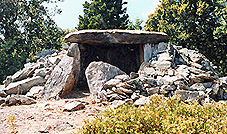 You are now entering an unknown world. A particular land, which has its own unique place in history. A history which has not yet been completely uncovered. Legends from the realm of Oc puzzle archeologists and historians, who are unable to prove that these legends are just mere legends. This is an ancient land. The earth of Occitania was sacred to the Celts. Many stone circles and dolmen are quiet witnesses of their respect for the land. Some areas are called "Lavaldieu" or "Terre de Dieu" (valley or land of God).
You are now entering an unknown world. A particular land, which has its own unique place in history. A history which has not yet been completely uncovered. Legends from the realm of Oc puzzle archeologists and historians, who are unable to prove that these legends are just mere legends. This is an ancient land. The earth of Occitania was sacred to the Celts. Many stone circles and dolmen are quiet witnesses of their respect for the land. Some areas are called "Lavaldieu" or "Terre de Dieu" (valley or land of God).Today, scholars speculate on the presence of Egyptian culture in the Languedoc in Celtic times, well over 3000 years ago. The Languedoc was also discovered by Greeks and Phoenicians who were always looking for a new place to colonize. In their footsteps came the Romans, who founded Narbonne and are responsible for the first hardened road of Gaul. From turbulent Palestine, more and more Jews sought refuge in Occitania and founded communities here and improved the vine culture. In Occitania everyone was relatively safe and life was good.
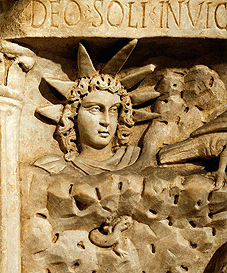 In the meantime, old religions like the Sol-Invictus or Sulis-Minerva and Isis/Diana/Ar-temis cults were very popular. The name Gaul does not only refer to the rooster, it also symbolises the circle, both symbols of the sun. The esoteric knowledge and wisdom which was given by the ancients to the Egyptians and then to the Jewish people, was kept safe here well into the Middle Ages, while the rest of Europe was kept in darkness, at the time created by a science fearing Church. Even today, archeologists unearth ancient suntemples. Even the Knights Templar were involved in the suncult. The eagle, who flew so close to the sun, high up in the sky, soon became the symbol of one of the strongest and most travel-hungry tribes of Israel, the tribe of Dan, ancestors of the Visigoths.
In the meantime, old religions like the Sol-Invictus or Sulis-Minerva and Isis/Diana/Ar-temis cults were very popular. The name Gaul does not only refer to the rooster, it also symbolises the circle, both symbols of the sun. The esoteric knowledge and wisdom which was given by the ancients to the Egyptians and then to the Jewish people, was kept safe here well into the Middle Ages, while the rest of Europe was kept in darkness, at the time created by a science fearing Church. Even today, archeologists unearth ancient suntemples. Even the Knights Templar were involved in the suncult. The eagle, who flew so close to the sun, high up in the sky, soon became the symbol of one of the strongest and most travel-hungry tribes of Israel, the tribe of Dan, ancestors of the Visigoths.
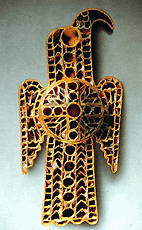 Two Lords of Carcassonne from the Trencavel Family had the middle name "Aton", an Egyptian diety from the 18th Dynasty of Achnaton, the Pharao of the Sun. In this fascinating period in history, many aspects of the Jews originated, such as the Ten Commandments, the Ark of the Covenant and the reunion of their faith in only one God. Mozes had learned much of this ancient knowledge, when he was still living at the Egyptian royal court. This knowledge would give him and Aaron, who was the High Priest of Heliopolis at the time, the strength and power which was needed to materialize the Exodus. From Palestine, several tribes went to the Balkan and onwards to western Europe and Scandinavia. And this is how the eagle of Dan came to the west (see the picture on the left, the Visigoth Eagle). You now clearly see the link between the tribe of Dan and the Visigoths, and several noble families of Europe.
Two Lords of Carcassonne from the Trencavel Family had the middle name "Aton", an Egyptian diety from the 18th Dynasty of Achnaton, the Pharao of the Sun. In this fascinating period in history, many aspects of the Jews originated, such as the Ten Commandments, the Ark of the Covenant and the reunion of their faith in only one God. Mozes had learned much of this ancient knowledge, when he was still living at the Egyptian royal court. This knowledge would give him and Aaron, who was the High Priest of Heliopolis at the time, the strength and power which was needed to materialize the Exodus. From Palestine, several tribes went to the Balkan and onwards to western Europe and Scandinavia. And this is how the eagle of Dan came to the west (see the picture on the left, the Visigoth Eagle). You now clearly see the link between the tribe of Dan and the Visigoths, and several noble families of Europe.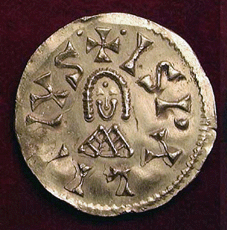 In the early Middle Ages, the kings of the Visigoths and Merovingians ruled in Occitania, one of the richest parts of Europe and also one of the safest. They were in legend the Grail kings. Tales about King Arthur spread quickly and the Troubadours sang of courtly love. Chivalry was invented. But this wonderful era would not last long. In this Visigoth coin you can see what inspired the Knights Templar to create their famous pointed cross.
In the early Middle Ages, the kings of the Visigoths and Merovingians ruled in Occitania, one of the richest parts of Europe and also one of the safest. They were in legend the Grail kings. Tales about King Arthur spread quickly and the Troubadours sang of courtly love. Chivalry was invented. But this wonderful era would not last long. In this Visigoth coin you can see what inspired the Knights Templar to create their famous pointed cross.
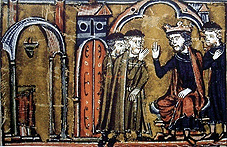 When the Crusaders conquered Jerusalem in the 12th century, the new order of the Knights Templar searched the Temple mount and found relics, treasures and knowledge of the old kings of Juda. From that moment on a new era of cathedral building and architecture was introduced: the Gothic style. Many strange constructions were copies of star systems or pentagrams. This, however, was also done in a more ancient period of human history, for instance at Giza and Ankhor. The Knights Templar discovered ancient sea routes, which enabled them to discover new territory, among which Nova Scotia (New Scotland), centuries before Columbus is known to discover America. And even he sailed with the red Templar cross on his sail. But what did the Knights Templar find in the Orient? What secrets did they keep from their Lord and Master, the Pope?
When the Crusaders conquered Jerusalem in the 12th century, the new order of the Knights Templar searched the Temple mount and found relics, treasures and knowledge of the old kings of Juda. From that moment on a new era of cathedral building and architecture was introduced: the Gothic style. Many strange constructions were copies of star systems or pentagrams. This, however, was also done in a more ancient period of human history, for instance at Giza and Ankhor. The Knights Templar discovered ancient sea routes, which enabled them to discover new territory, among which Nova Scotia (New Scotland), centuries before Columbus is known to discover America. And even he sailed with the red Templar cross on his sail. But what did the Knights Templar find in the Orient? What secrets did they keep from their Lord and Master, the Pope?
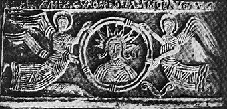 Here we can see Jesus replacing Sol Invictus and its related Mithras cult. Throughout the milennia, fertility goddesses, the heavenly Mother, Mother Earth and sungods could continue to exist under new names. They took over the ancient rituals and this is how the ancient rituals also ended up in Christianity.
Here we can see Jesus replacing Sol Invictus and its related Mithras cult. Throughout the milennia, fertility goddesses, the heavenly Mother, Mother Earth and sungods could continue to exist under new names. They took over the ancient rituals and this is how the ancient rituals also ended up in Christianity.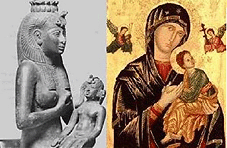 The Egyptian Isis and Horus were models for Mary and baby Jesus. In the first centuries of Christianity this was the only way to get the populus accustomed to the new saints. The real people who were the models for Mary, Jesus and many other Biblical people, probably did exist, however, they may not have lived the lives which were recorded in the Bible. The stories of their lives, of course, needed to be adapted to the ones everyone already knew. The stories of the old gods. And this is why 'our' Jesus reminds us of Mithras, Apollo, Sol Invictus and Osiris.
The Egyptian Isis and Horus were models for Mary and baby Jesus. In the first centuries of Christianity this was the only way to get the populus accustomed to the new saints. The real people who were the models for Mary, Jesus and many other Biblical people, probably did exist, however, they may not have lived the lives which were recorded in the Bible. The stories of their lives, of course, needed to be adapted to the ones everyone already knew. The stories of the old gods. And this is why 'our' Jesus reminds us of Mithras, Apollo, Sol Invictus and Osiris.The Knights Templar were clearly in the possession of important knowledge. They discovered the similarities between the old gods and several aspects of Christianity, through which they became even more curious. The Knights Templar learned from others about the knowledge of measure, weight and number, of orientation points all over the world, of the stars and, most likely, they also learnt the true history of the first century. The history which was kept secret, because it did not fit the message that the Church wanted to give the world at that particular time. The real story of Jesus and Mary Magdalene. And so, the Knights Templar became a threat to the Church of Rome.
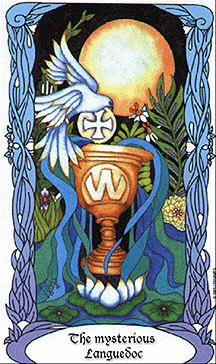 The Knights Templar, who were very rich, wanted to live here in Occitania. This would have become their home base, free from the rule by kings or popes. They obeyed no one. Both king and pope would not tolerate this any longer. On Friday 13th 1307 the Templars were arrested, tortured for confessions of heresy, and soon after, the Order was liquidated. Their leaders were even burned at the stake. The only place left for the Templars to exist was Scotland, while in other countries the Order simply changed its name, e.g. to the "Knights of Christ" in Portugal. Many of their possessions were hidden in caves, sealed church vaults or, as legend tells us, shipped to Nova Scotia during their last hours, just before the arrest. Only one man was perhaps able to find a tiny part of their "treasure". This man is the charismatic abbot Saunière of Rennes-le-Chateau, who suddenly became very rich at the end of the 19th century, after he had opened the vaults beneath the village church of La Madeleine (Mary Magdalene) in order to restore the church. No one knows exactly what he really found.
The Knights Templar, who were very rich, wanted to live here in Occitania. This would have become their home base, free from the rule by kings or popes. They obeyed no one. Both king and pope would not tolerate this any longer. On Friday 13th 1307 the Templars were arrested, tortured for confessions of heresy, and soon after, the Order was liquidated. Their leaders were even burned at the stake. The only place left for the Templars to exist was Scotland, while in other countries the Order simply changed its name, e.g. to the "Knights of Christ" in Portugal. Many of their possessions were hidden in caves, sealed church vaults or, as legend tells us, shipped to Nova Scotia during their last hours, just before the arrest. Only one man was perhaps able to find a tiny part of their "treasure". This man is the charismatic abbot Saunière of Rennes-le-Chateau, who suddenly became very rich at the end of the 19th century, after he had opened the vaults beneath the village church of La Madeleine (Mary Magdalene) in order to restore the church. No one knows exactly what he really found.Another theory tells of documents and the story of Mary Magdalene, who came to Occitania in the 1st century CE. She may have taken with her several items, on which the world still speculates today. Was it the Holy Grail, ancient knowledge, a bowl or cup, the children of Jesus (the Grail bloodline) or all of this? We may never find out exactly.
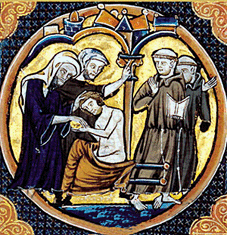 Other religious groups which were not tolerated in the rest of Europe, like the Cathars, flourished in Occitania. They did not believe that Jesus died on the cross, did not need a church and certainly no dogma. This was the cause of their dreadful fate, because it lead to one of the bloodiest episodes in history. Apart from the crusades to the Holy Land, there was another crusade, the Albigenzian crusade. Peaceful, loving and hardworking people who merely had a different faith, were tortured and burned alive. To be absolutely sure that no Cathar would escape the flames, the Dominican Order and the pope created an institution to cause so much fear, that people would betray their own parents, siblings, or neighbours. The Holy Inquisition. However, not all Cathars were killed. Many fled to the mountains, and many perished from hunger or cold during this harsh journey. Others simply went underground or founded small villages deep into the mountain forests. Did these people possess holy relics, the knowledge of the Hermetica? Did they protect the Grail bloodline? And how can we trace all this in modern day Occitania?
Other religious groups which were not tolerated in the rest of Europe, like the Cathars, flourished in Occitania. They did not believe that Jesus died on the cross, did not need a church and certainly no dogma. This was the cause of their dreadful fate, because it lead to one of the bloodiest episodes in history. Apart from the crusades to the Holy Land, there was another crusade, the Albigenzian crusade. Peaceful, loving and hardworking people who merely had a different faith, were tortured and burned alive. To be absolutely sure that no Cathar would escape the flames, the Dominican Order and the pope created an institution to cause so much fear, that people would betray their own parents, siblings, or neighbours. The Holy Inquisition. However, not all Cathars were killed. Many fled to the mountains, and many perished from hunger or cold during this harsh journey. Others simply went underground or founded small villages deep into the mountain forests. Did these people possess holy relics, the knowledge of the Hermetica? Did they protect the Grail bloodline? And how can we trace all this in modern day Occitania?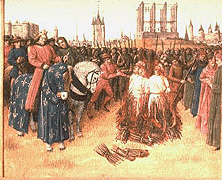 Cathar castles are all over the land. Holy water places and other sanctuaries remind us of Artemis and Isis. Esotheric orders such as the Freemasons and Rosicrucians leave mysterious symbols in churches and on gravestones. Medieval painters include secret codes in their paintings which are only visible to the initiated (solis sacerdotibus). A parchment arrives in Paris which proves that Jesus was still alive in 45 AD. And it vanished without a trace. Many books are written about the Enigma of Rennes-le-Chateau in which authors speculate on Templar gold, the true story of the 1st century, a tomb in which the remains of Jesus rest, and little by little we discover pieces of the puzzle hidden by the church of Rome. The image which is now becoming clearer everyday, reveals that the legends are no legends at all. They are hidden pieces of true history. The mysterious history of Occitania.
Cathar castles are all over the land. Holy water places and other sanctuaries remind us of Artemis and Isis. Esotheric orders such as the Freemasons and Rosicrucians leave mysterious symbols in churches and on gravestones. Medieval painters include secret codes in their paintings which are only visible to the initiated (solis sacerdotibus). A parchment arrives in Paris which proves that Jesus was still alive in 45 AD. And it vanished without a trace. Many books are written about the Enigma of Rennes-le-Chateau in which authors speculate on Templar gold, the true story of the 1st century, a tomb in which the remains of Jesus rest, and little by little we discover pieces of the puzzle hidden by the church of Rome. The image which is now becoming clearer everyday, reveals that the legends are no legends at all. They are hidden pieces of true history. The mysterious history of Occitania.